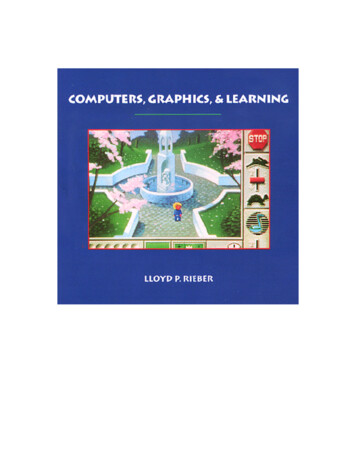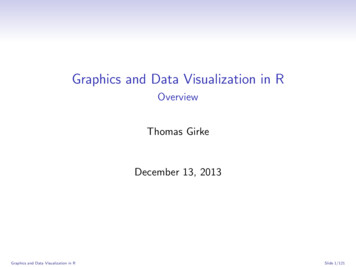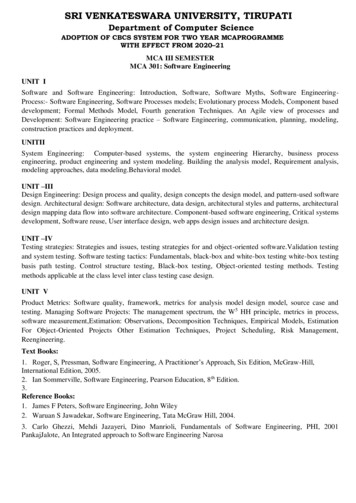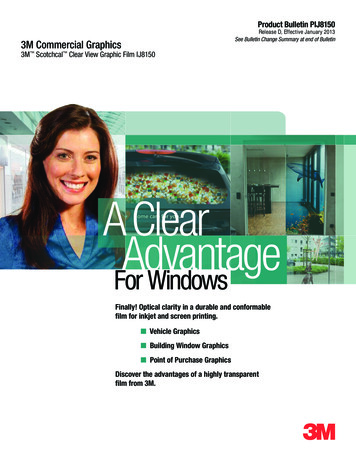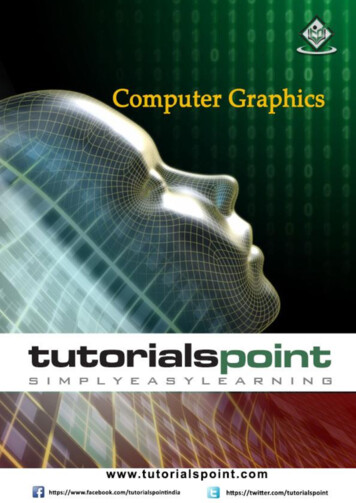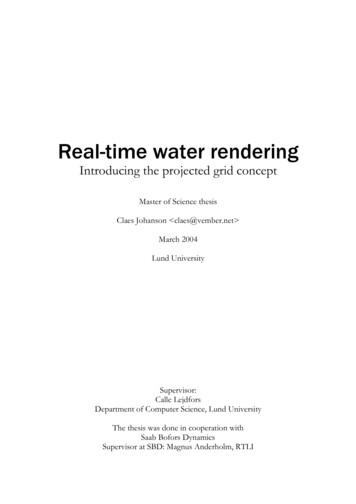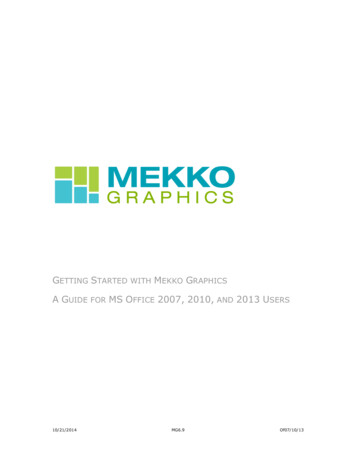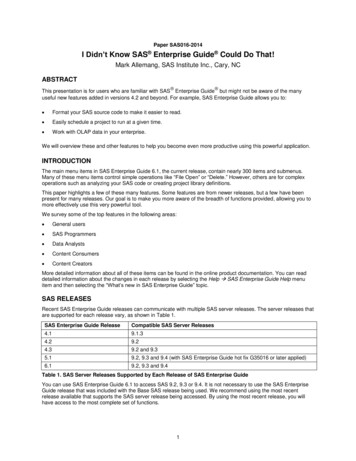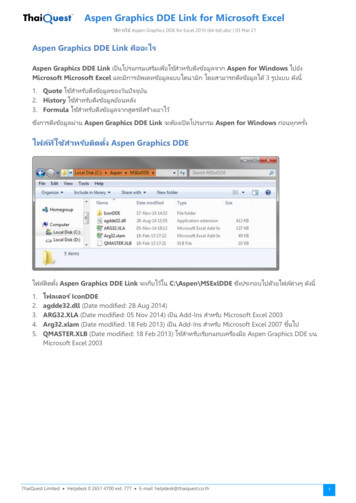
Transcription
Computer Graphics in Practice:Beyond Games and VFXVladimir KoylazovChaos GroupSIGGRAPH 2018
Overview VIZ existsIt is importantRendering requirements for different industriesSome thoughts on the future
WE ARE CHAOS GROUPWe create powerful rendering and simulation technologyto help you visualize anything imaginable. Global leader in computer graphics, over 20 years experience V-Ray is the industry standard for top design studios, architectural firms,advertising agencies, and visual effects companies 92 out of the top 100 architecture firms use V-Ray V-Ray portfolio includes V-Ray for 3ds Max, Maya, MODO, Nuke, Katana,Rhino, SketchUp and Revit, Corona Other products include VRscans, photoreal scanning technology andmaterial library, Phoenix FD for fluid dynamics and PDPlayer Our R&D division is shaping the future of creative storytelling, virtual realityand digital designchaosgroup.com
Our missionSolving hard problems so you don’t have to Includes constantly looking into new technologies that may help our customersAlso searching for hard problems that need solutions
Computer graphics in practice When I mention computer graphics, students typically imagine These are the most famous applications of CG GamesVisual effects for film and TVThey are great!However most of our users render visualization projects Interior designArch VizProduct Viz
Why visualization is important? Architecture is important You literally live your life in itProduct design is important You use those products every day
Computer graphics products Many products, especially renderers, are specialized Realtime renderers for gamesRenderers for film VFX/TV workRenderers for arch vizRenderers for product vizThe different applications have [slightly] different requirements These requirements are very starting to converge somewhat
V-Ray is unique because it is used in all areas V-Ray as a renderer, has been widely used in all areas of CG And even in newer areas like training AIWe’ve had the opportunity to observe the different requirements and attitudes of users inall CG areasBeing based exclusively on raytracing is what made it all possible Even for realtime - project Lavina
DCCs and different integrations VFX-oriented DCCs ArchVIZ-oriented DCCs Maya, Houdini, Katana, 3ds MaxSketchUp, 3ds Max, ArchiCADOthers Cinema4D, Rhino, etc
Rendering requirements Different industries have slightly different rendering requirementsIt is interesting to explore them in a bit more detail
Data size Film renderers Large amounts of geometry (often subdivided/displaced)Large amounts of textures (usually tiled .tx files) - thousands of files– Data resides on a network location to be consumed by the render farm– Could be a large bottleneckArchViz renderers Generating large amounts of textures is very easy these days, even if it is not strictly necessary for the projectRelatively less texturesVarying file formats (JPG, PNG etc)Data is often local on artists’ workstationProxies turned out to be particularly useful for both areas A way for the renderer to directly load geometry bypassing the DCC
Scene organization Film renderers Tightly controlled pipeline, mostly split into different stagesModeling, texturing, lighting, compositing are done by different peopleThe renderer must allow data to come in and out of the renderer– Object properties, overrides, shader controls based on scene data is important–– Support for common and standard file formats - Alembic, .tx, OpenEXR etcOften different versions of the same shot need to be rendered - for masks/holdouts, shadow extraction etc.It is useful to be able to do those overrides without changing materials - f.e. through object propertiesArchViz renderers Scenes can be built from publicly available modelsVarying model qualityVarying input texture file format and shaders– Materials specifically used to be a problem before because of material quality settings (sampling) embedded in materials instead ofbeing handled automatically by the rendererNot much need to move data in and out of the renderer, in fact staying in the renderer even for post
Project duration Film renderers Projects take a longer period of time, usually monthsThere is time to research how to solve specific problems or issues (usually, less so nowadays)ArchViz renderers Projects usually have a relatively quick turnaroundThere isn’t a whole lot of time to spend on rendering itself
Renderer output Film renderers Sequences of frames (shots)– Many thousands of frames in a projectRender elements to separate various components of the scene for adjustment/compositing in post– Lots of animated stuff going on in each shot - characters, explosions, vehicles, destruction etcWorld positions, extra textures etc.Deep output support might be neededUsually post-processing happens in a dedicated compositing application like Nuke or FusionArchViz renderers Sometimes there are animations–– Mostly the results are still images– Sometimes very large stills - distributed rendering is usefulRender elements to adjust scene in post– Usually walk-throughs or other presentation formats, not a whole lot of moving thingsAnimations are increasingly moving over to realtime engines these daysUsually masksPost-processing happens either in the frame buffer, or in PhotoShop
Additional tools A renderer is sometimes expected to provide additional tools Scattering toolsVariation tools (texture randomization etc)Landscaping is a large part of ArchVIZ Creating the natural environment around a buildingTrees, grass, flowers
Lighting Lighting in VFX The goal is often to match the look of a given background plate as a referenceIBL is used all the timeMore artistic control required in order to match a given background plate or to achieve a specific look– Separate control over diffuse and specular contributions, light linking, light filters/blockersArtistic light units (f-stops and exposure)ArchVIZ requires more exact tools There is no reference - the renderer must say what the scene looks like, without any referencesSun & Sky system for daylight scenesIES lights and area lights with prescribed intensityPhysical light units (lumen, lux, candela etc)
Global illumination GI in VFX Was avoided for a long time due to restrictions of the toolsOnly relatively recently VFX moved to raytracing exclusivelyUsually one or two bounces are enough when you render a character against a plateTricks to suppress fireflies are allowed with less regard for physical accuracyBrute force strategies work wellArchVIZ ArchVIZ users were pioneers here–– Starting with radiosity solutions for lighting analysisMoving to raytraced GI in the beginning of the 21st centuryAccurate light distribution is important - one or two bounces are not enoughSpecialized algorithms must be used to handle large number of bounces efficiently––Light cache in V-RayUHD cache in Corona
Materials Materials in VFX Skin, hair materials are importantProgrammable shaders might be important (OSL, shading SDK)– Artistic control might be importantShading networks can be very complicated– Lots of blend materials, masks, color correction textures etcDriving shaders through scene data or metadata is important– Could be a burden to the performance, or the development (keeping compatibility), but very helpful to customize the rendererUser attributes, bitmap file name tags etc.Materials in ArchVIZ Physical accuracy is importantMaterials for vegetation (foliage, grass), curtains etcPrebuilt material libraries might be importantProgrammable shading is not importantProcedural shading, variations might be important
Some features are used differently Hair primitives 2D displacement Used for characters in VFX - hair, facial hair, peach fuzz, animal furUsed for carpets, rugs, blankets, grass in ArchVizUsed for skin and fine character detail in VFXUsed for stone and brick walls, roof tiles, pavement etcFrame buffer Used for previewing the output and explore render elements om VFXIn ArchVIZ, also used as a post-processing tool, sometimes final post-processing is done there without postSometimes this leads to concept clashes like LUT files
Renderer setup A bit more time is available in VFX for setting up a renderer Different settings per shot might be requiredThere are multiple iterations over a shot that allow settings to be fine-tunedNon-adaptive (fixed) sampling is acceptable, with manual control over every sample– Takes a while to find the right settings, but the time is amortized over hundreds of animation framesThere is less time available in ArchVIZ The renderer must be able to handle many different types of projects with minimal settingsAutomatic/adaptive sampling is preferable, with only quality/max time specified as input
Render farm resources In VFX, usually whole frames are distributed Hundreds or thousands of machinesRender farm can spill to the cloud if neededOccasionally DR is used for iterations during lightingSoftware for render farm management is usedIn ArchVIZ, often a single frame is distributed DR is often used for final results (stills)A few machines only available, sometimes office workstations (no dedicated render farm)Commercial render farm services handle the restCloud is less used because of complicated setup–V-Ray Cloud aims to change that
Workflows move between industries VFX workflows leaking into ArchVIZ OpenEXRCryptomatteLUTs and post-processingLots of research is done initially for VFX and then trickles down to ArchVIZ–––– Accurate BRDFs (f.e. GGX)Volume renderingHair/fur shadingPBR-style materialsAnd the other way round Scattering tools for environmentsGlobal illuminationPhysical materials/lighting
Real time rendering Real time rendering in VFX Previz, playblastsOccasionally for final frames or parts of final frames– Real time rendering in ArchVIZ Recently entire short films/TV series are rendered in real time enginesWalk-throughsSpace exploration/VRInteractive experiencesReal time engines Game engines repurposed for specific workflows– Game-specific workflows might get in the waySpecialized real time engines for arch VIZ
Virtual reality Doesn’t work too well for entertainment Difficult to keep the attention of the viewer at the right spotNot very comfortable for longer viewingVery popular for ArchVIZ Shows off a space much better–––Still images - stereo panoramasWalk-throughsInteractive experiences
Final thoughts Can one rendering solution cover everything? VFXArchVIZRealtime
Questions?
Software for render farm management is used In ArchVIZ, often a single frame is distributed DR is often used for final results (stills) A few machines only available, sometimes office workstations (no dedicated render farm) Commercial render farm services handle the rest Cloud is less used because of complicated setup
